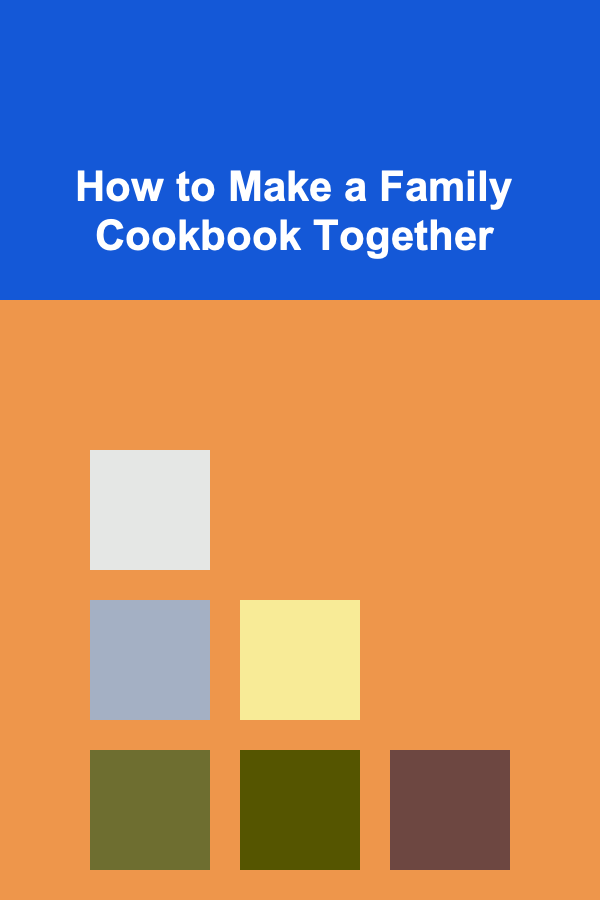
How to Make a Family Cookbook Together
ebook include PDF & Audio bundle (Micro Guide)
$12.99$8.99
Limited Time Offer! Order within the next:

Creating a family cookbook can be a meaningful and rewarding project that brings together tradition, creativity, and personal connection. Whether you want to preserve your family's favorite recipes, pass down culinary traditions to the next generation, or simply enjoy some quality time together, crafting a family cookbook is an excellent way to do so. This project offers an opportunity to reflect on your family's culinary history, share cooking tips, and celebrate the joy of food. It is also a beautiful way to pass down the love for cooking and mealtime traditions that can be enjoyed by generations to come.
In this guide, we will explore how to create a family cookbook that is rich with memories, recipes, and personal stories. We will cover every step of the process, from gathering recipes to designing and printing the book. Whether you want a simple handwritten cookbook or a professional-looking published edition, you will find helpful tips to make the project enjoyable and successful.
Why Create a Family Cookbook?
Before diving into the "how," it's important to understand why a family cookbook can be such a valuable project. Here are some of the key reasons why you should consider making a cookbook with your family:
1. Preserve Family Recipes
Family cookbooks often include beloved recipes passed down from one generation to another. Recipes for holiday meals, birthday treats, or weeknight dinners are often cherished and hold sentimental value. By compiling these recipes into one collection, you ensure that they are preserved for future generations.
2. Create a Legacy
A family cookbook can become a treasured heirloom that is passed down for generations. It can be a reflection of your family's culture, traditions, and values. Just as family photographs capture memories, a cookbook captures the essence of your family's culinary traditions.
3. Bond Over Cooking
The process of putting together a family cookbook offers a wonderful opportunity for families to spend time together in the kitchen. As family members share recipes, cook together, and reminisce about meals they've shared, they can bond over a shared love of food.
4. Share Family Stories
Food is not just about ingredients---it's also about memories and stories. Many recipes are tied to moments in time, whether it's a special holiday meal, a favorite vacation dish, or a grandparent's signature recipe. The cookbook allows you to capture these stories and preserve the rich history behind each dish.
5. A Perfect Gift
A family cookbook makes a thoughtful gift for birthdays, holidays, or special occasions. It's a personalized, heartfelt gift that can be shared with extended family members, friends, or future generations.
Step-by-Step Guide to Creating a Family Cookbook
1. Start with a Vision
Before jumping into the recipe gathering, it's important to have a clear vision of what you want the cookbook to look like and what its purpose will be. Ask yourself questions like:
- What kind of cookbook do I want to create? Will it focus on family favorites, holiday meals, or regional dishes?
- Should the cookbook be organized by meal type (e.g., breakfast, lunch, dinner) or by occasion (e.g., holiday recipes, weeknight dinners)?
- Who is the intended audience? Will the cookbook be for your immediate family, or do you want to share it with extended family or friends?
- Will the book include photos or stories along with the recipes?
Answering these questions will help guide the rest of the process and ensure that the finished product aligns with your goals.
2. Gather Recipes
The heart of any cookbook is, of course, the recipes. Start by collecting recipes from your family members. This is where the fun begins, as you begin to dig into your family's culinary history. Here's how to make this step effective:
A. Reach Out to Family Members
Reach out to relatives, especially older generations, who may have recipes that have been passed down through the years. Grandparents, great-aunts and uncles, and even distant relatives may hold the key to long-forgotten recipes.
B. Record Special Occasions and Family Traditions
Some recipes are tied to special events, such as family holidays, birthday celebrations, and milestone moments. Be sure to include these recipes in the cookbook, as they often carry the most memories. Ask family members to recall the dishes they most remember from holidays or family gatherings.
C. Document Recipes with Accurate Instructions
When gathering recipes, be sure to record them as accurately as possible. If the recipe is handed down orally or written in shorthand, take the time to write down the full instructions clearly. Note any specific details that could make the recipe turn out just right---like the type of flour, cooking techniques, or the importance of a certain ingredient.
D. Test the Recipes
If possible, try cooking or baking the recipes to ensure they turn out as expected. If you're unable to test every recipe, be sure to ask the person who contributed it for detailed guidance. This step ensures that your family members won't be frustrated trying to recreate the dish.
3. Incorporate Family Stories and Memories
As you collect recipes, take note of any special memories or stories that are associated with them. These stories can add a personal touch and make the cookbook even more special. You can include anecdotes about how the recipe came to be, any cultural significance behind it, or memorable moments shared around the dinner table. Here are a few ways to incorporate stories into your cookbook:
A. Personal Reflections
Ask each family member to write a short reflection or memory related to a particular recipe. These stories could include a funny mishap in the kitchen, a family tradition tied to a holiday meal, or a description of how the dish became a favorite.
B. Family Quotes
Include meaningful quotes from family members about their love for food or cooking. This could include sentiments like "My grandmother always made this dish on Sundays" or "This is the recipe that reminds me of home."
C. Photo Opportunities
Include photos of the dishes, especially those that have family significance. It can also be meaningful to include photos of the cooks preparing the dishes, or pictures from past family gatherings where the recipe was served.
4. Organize Your Cookbook
Once you have a collection of recipes, it's time to organize them. There are many ways to do this, depending on the type of cookbook you want to create.
A. By Meal Type
Organize recipes based on meal categories such as breakfast, appetizers, main dishes, side dishes, and desserts. This is a practical and straightforward approach that makes it easy to navigate.
B. By Occasion
If your family has specific recipes for holidays, birthdays, or special occasions, you could organize the cookbook around these themes. For example, a chapter for Christmas recipes, another for summer barbecue recipes, and another for birthday cakes.
C. By Family Member
You can also organize the cookbook by family members, so that each person has their own section. This allows the family to feel a greater sense of ownership and pride in the cookbook.
D. By Difficulty
Another fun way to organize the cookbook could be by difficulty---easy weeknight dinners, advanced dishes for special occasions, or even a "kid-friendly" section for younger family members.
5. Design the Cookbook
Designing the cookbook can be as simple or as elaborate as you like. Here are a few considerations for the design phase:
A. Cover Design
The cover of the cookbook sets the tone for the entire book. You can design a simple cover using a family photo, a beautiful food image, or a custom illustration. It's important to make the cover visually appealing and reflective of the family's personality.
B. Layout and Style
The layout of the cookbook is crucial for readability. Choose a font that is easy to read and make sure there's enough spacing between the recipe title, ingredients, and instructions. If you're working with photos, make sure they are high quality and placed appropriately alongside the recipes.
C. Include Indexes
An index or table of contents is essential, especially if your cookbook is filled with a large number of recipes. Include sections for easy reference, such as a recipe index by name or an ingredient index to help you find recipes based on available ingredients.
D. Use Software or Hire a Professional
If you're comfortable using design software, you can use programs like Adobe InDesign or Canva to lay out your cookbook. Alternatively, you can hire a professional designer to help bring your vision to life.
6. Print and Publish
Once your cookbook is ready, it's time to bring it into the world. There are a few ways to handle the printing process:
A. Self-Printing
If you're looking to make a few copies for personal use, you can print the cookbook yourself at home or take it to a local printing service. For a more polished look, consider using online printing services like Shutterfly, Blurb, or Lulu.
B. Professional Publishing
If you want a higher-quality, professionally printed cookbook, consider working with a publisher or printing company that specializes in small runs. They can help you with printing, binding, and distribution.
C. Digital Cookbook
If you're tech-savvy or prefer a digital version, you can also create an eCookbook to share with family members. This could be distributed through email, a private family website, or platforms like Amazon Kindle.
7. Share the Cookbook
Once your family cookbook is complete, it's time to share it. You can distribute copies to family members at reunions, holidays, or as a special gift. Many families enjoy the tradition of gifting the cookbook during family gatherings, making it a celebratory experience.
Conclusion
Creating a family cookbook is a deeply meaningful and fulfilling project that can strengthen family bonds, preserve cherished recipes, and create a lasting legacy for generations to come. Whether you choose to make it a simple collection of recipes or a professionally designed work of art, the effort you put into crafting this book will undoubtedly be appreciated by your family for years. More than just a collection of ingredients and instructions, a family cookbook is a celebration of tradition, memories, and the timeless joy of sharing meals together.
Reading More From Our Other Websites
- [Personal Finance Management 101] How to Deal with Financial Setbacks and Stay on Track
- [Home Cleaning 101] How to Clean Your Bathroom Like a Pro in 10 Minutes
- [Rock Climbing Tip 101] The Evolution of Climbing Ropes: From Natural Fibers to High‑Tech Hybrids
- [Home Soundproofing 101] How to Create a Soundproof Home Office for Better Focus
- [Home Family Activity 101] How to Plan a Home Spa Day for the Whole Family
- [Tie-Dyeing Tip 101] Beyond the Classic Swirls: Modern Tie-Dye Techniques to Elevate Your Wardrobe
- [Personal Care Tips 101] How to Apply Dry Shampoo on Wet Hair for a Fresh Feeling
- [Organization Tip 101] How to Organize Your Moving Process with Checklists
- [Home Party Planning 101] How to Host a Single-Theme Food Tasting Party
- [Personal Care Tips 101] How to Do Exercises for Pelvic Floor Strength and Tone

10 Cheap and Healthy Snack Options for Busy Lifestyles
Read More
How to Involve Tenants in Property Maintenance Efforts
Read MoreHow to Use Spreadsheets for Document Tracking
Read More
How To Understand the Concept of the Hero's Journey
Read More
How to Interpret Ancient Astronomy and Calendars
Read More
Choosing the Right Dog for Your Family: A Comprehensive Guide
Read MoreOther Products

10 Cheap and Healthy Snack Options for Busy Lifestyles
Read More
How to Involve Tenants in Property Maintenance Efforts
Read MoreHow to Use Spreadsheets for Document Tracking
Read More
How To Understand the Concept of the Hero's Journey
Read More
How to Interpret Ancient Astronomy and Calendars
Read More